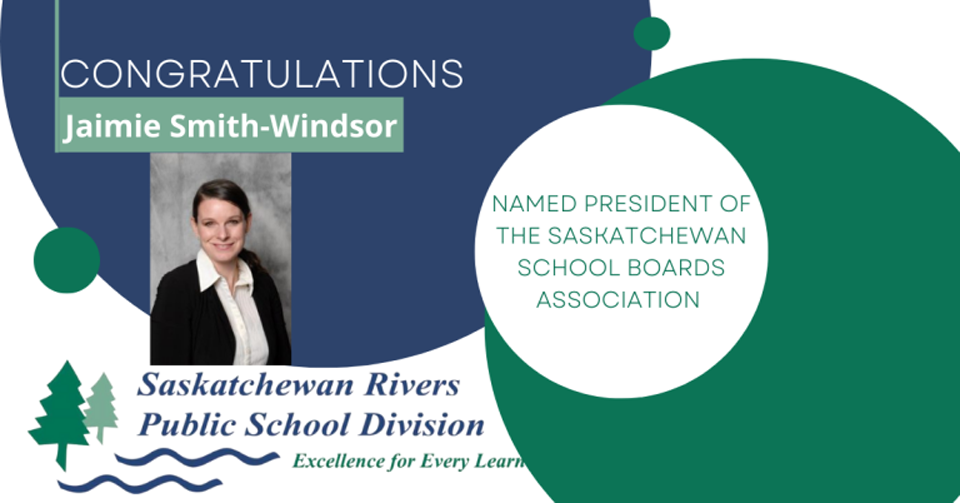PRINCE ALBERT - Saskatchewan Rivers School Division rural trustee Jaimie Smith-Windsor is the new president of the Saskatchewan School Boards Association (SSBA) after being acclaimed at the three-day Fall Assembly in Regina.
Smith-Windsor moves up from vice president and replaces Shawn Davidson, who will now serve as vice president. Smith-Windsor was grateful to be chosen by her peers.
“It’s really an honour to be given this opportunity to serve boards of education,” she said. “I think (having a) local voice in education is one of the most important ways that the public can stay engaged in education and have representation, … so it’s a real honour and a real privilege to serve boards in this way.”
Smith-Windsor served one term as vice president, and two terms as the Central Constituency representative. She’s confident that experience will help her lead the SSBA.
“I feel very familiar with the table and the leadership of the SSBA,” she said. “It really is a high performing organization that I have become quite familiar with, and I feel ready.”
Smith-Windsor added that she’s also happy for the opportunity to continue working with Davidson, who she called “a very engaged leader” in the education sector.
“I’m really glad to have the opportunity to work alongside him again. He has a lot to contribute. We have a very strong executive team,” Smith-Windsor said.
Many other constituency representatives were also re-elected, so the leadership is stable at the SSBA.
“That has nothing to do with apathy and has everything to do with the kind of leadership team we have around the table,” Smith-Windsor said.
Smith-Windsor explained that the goals for her term will come directly from those the SSBA serves. A big part of that is the resolutions put forward during the AGM at the Fall Assembly.
“It is all about membership engagement,” she said. “It is all about staying connected to the boards and the voices that know their communities from all around the province and respecting the diversity of distinct boards of education and leading from there.”
Smith-Windsor added that taking direction from the association is an example of democracy in action.
“We have got boards debating and coming from different perspectives and different contexts to arrive in a position that we can take forward to advocate for different changes in our education system,” she said.
The AGM was particularly exciting for the Saskatchewan Rivers Board because they had sponsored two resolutions to be debated at the event.
The first resolution stated “Be it Resolved that the Saskatchewan School Board Association Executive begin discussions with the Ministry of Education to make joint recommendations relative to the education mill rate.”
“That is a really important one because I think there is a lot of interest in having a bigger public conversation about how education is funded in the province,” Smith-Windsor said. “Boards have been living under the cost of inflation for a decade and are interested in being more collaborative on how education is funded and how we can strengthen the education system through investment.”
The rationale behind this resolution was that with the Provincial Education Plan in its final stages of development, it is crucial that the cost of implementing that plan be supported by funding that is stable, predictable, and sufficient to meet the needs of students.
A portion of educational funding comes from Education Property Tax, so it is essential that Boards and the SSBA collectively have the opportunity to be part of the discussion and decisions relative to the mill rate. This resolution was carried with a high level of support from the Boards represented in the association.
The Second resolution stated be it resolved that the Saskatchewan School Board Association begin discussions with the Ministry of Education to jointly review and make recommendations on funding, oversight and accountability for all independent schools including Associate Independent Schools and Alternative Independent Schools.
“From a school board’s perspective, we believe that the publicly funded education system that we have is built on these principles of inclusion and accountability and transparency,” Smith-Windsor explained. “Here is an opportunity to have some discussion about what that looks like in the world of independent schools.”
Some examples of items missing in independent schools are having qualified teachers, public financial reporting and fiscal responsibility and following provincial curriculum like other school divisions.
“We have direct input as boards of education into curriculum that is considered by the province,” she said. “We feel we have a pretty strong provincial curriculum that is important to follow. There was also some discussion around having some conversation around inclusion and principles like that as being important to boards as well.”
While being debated, the resolution was amended to include the oversight and accountability for independent school operations.
The amended resolution presented above was also carried by the delegates with support from across the province.
Smith-Windsor is beginning a two-year term and eager to get started right away.
“I’m jumping in with both feet and certainly looking forward to the role ahead,” she said.




